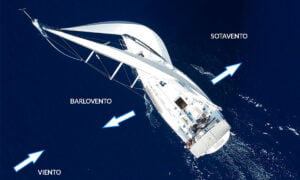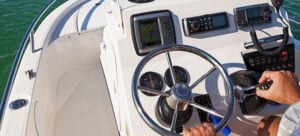Mooring and undocking
The docking on point consists of tying bow or stern to dock, generally next to other boats moored in the same way.
gorging on alongside a dock or pontoon is to tie up parallel to the dock.
For this maneuver it is important that the defenses of the side that we are going to approach the dock are up to protect the side of the boat.
Point docking maneuvers
Point docking with off-shore wind: the bow will be brought closer to the wharf to make it fixed on it. two long Once the bow is separated from the dock by the bow action of the wind, make the elbow firm or dead at the stern.
If he wind is from the sea Instead of making the bow lengths firm first, the elbow pad is made firm or dead.
Docking sideways with off-shore wind: the approach must be done very slowly and being a few two lengths the engine stops leaving it in neutral and
taken off will be enough to bring the bow closer to the edge of the dock and give the length of the bow as the first line.
The maneuver if the wind is from the sea is the same except that engine stop is done before since the same wind will steel our bow.
Point undocking maneuver
Undocking of vessels docked at point: the mooring lines will be released depending on the prevailing wind, as well If it is made of land, the
elbow pad (dead) and later the long going slowly forward or backward depending on whether the docking has been done bow or stern, paying special attention if you have boats to leeward. For the case that the wind is from outside (from the sea) they will be released the long ones and later the elbow pad making the exit in the same way with special attention to the lee side.
Undocking of vessels docked alongside
Wind or current from the bow or bow
In this case, as the wind pushes us over the bow we must prevent the boat from going backwards and hitting other boats. To do this we will first start the bow thrust (1) and the stern length (2) which causes the boat to begin to separate from the dock, leaving the rest minus the stern spin, moving forward very slowly and with rudder to the side and once the boat in front had been saved we release the stern spin.
Wind or current from the stern or quarter
In this case, when the wind pushes us from the stern we must prevent the boat from going forward and hitting other boats.
To do this we will first start the stern thrust (1) and the bow length (2) which causes the boat to begin to separate from the dock, taking off the
rest minus the stern length, moving forward very slowly and with the rudder on the corresponding side so that once the boat in front has been saved we release the stern length.
Wind or current through the beam
In this case The order of ending the ends is not extremely important., if the wind or current it's from the sea can release the bow moorings first so that, helping ourselves with a boat hook, we can open the bow.
If the wind or current is from land, it is better to release both thrust first and then the length of the bow so that it opens and finally the stern length.
Are you interested in: Course and steering rules
Harness to another boat
The term abarloarse is known as the maneuver of docking alongside another vessel.
To do this, the same rules are followed as for docking at a dock, but taking even more precautions due to the danger that a bad maneuver may pose. Both the abarloante and the abarloado they will lay down their defenses by the corresponding band.
This type of maneuver is common due to the lack of space in many ports, especially when there are influxes of many vessels due to special events or summer seasons.
The stern and bow thrusts and traverses must be given to the berthing boat and the lengths to the bollards or bollards of the port. In turn, it must be hooded so that it does not disturb the rest of the boats, especially in case they need to undock.
When the boat abarloante this anchored The maneuver must be carried out in places with shelter and with wind and calm seas.
He Approach will be made from the stern with the fenders drawn and with the splines and traverses already prepared, it is advisable for the anchored boat to file more chain to avoid dragging.
If the boat abarloante is adrift and there are bad seas unless it is a serious case (eg evacuating a sick crew member) it should be avoided. To carry it out in the event that both vessels they beat the same or the boat that helps is larger, we approach because of its windward and thus we protect it (socaire) while if it is the helped the greatest or abates the most we will do it for leeward.
Also in the event of fire The approach must be made by windward.
moor to a buoy
When possible, especially for space, we will approach bow to the wind, and having it on one of the bows the rope was caught with the boat hook.
If this is not possible we will do it for its windward and when we have it across our path, it will move forward slowly so that the wind blows it over our side.





